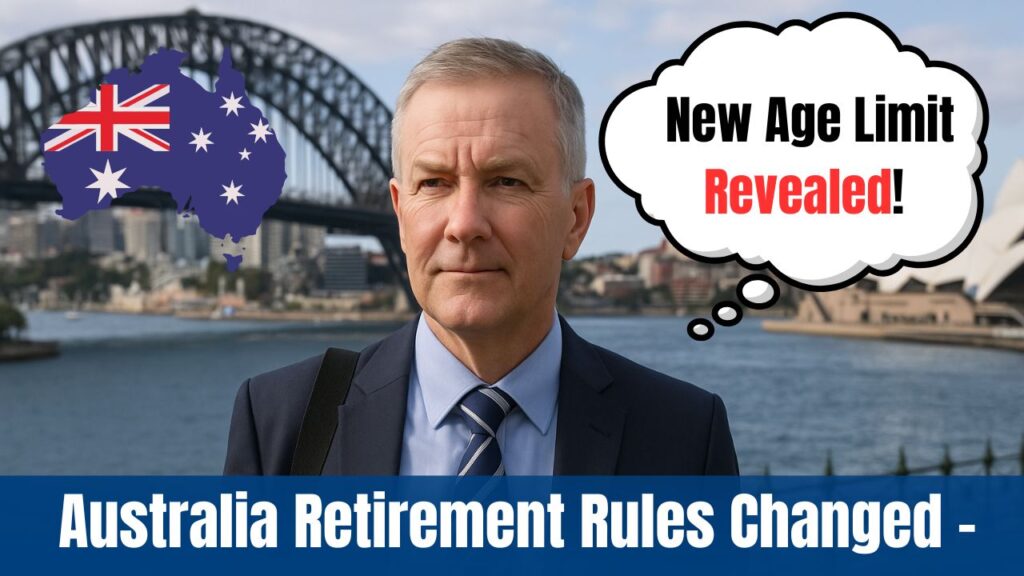Australia has officially revised its retirement age policy for government employees in 2025, marking a significant shift in public service careers. The new rule, announced by the Commonwealth Government, adjusts the retirement age threshold in an effort to align with increasing life expectancy and longer working capabilities. This move aims to improve long-term financial security, support economic sustainability, and reduce early pension burdens. Public servants now face a new age limit for retirement, prompting questions about pension eligibility, superannuation impacts, and planning strategies. Here’s everything Australian government workers need to know about the updated age rule.

New Public Sector Retirement Age Limit in Australia 2025
The Australian Government has officially increased the retirement age for public sector workers to 67, effective from 1 January 2025. This change applies to federal employees across departments, with exceptions for specific frontline roles. The shift from the previous age of 65 is part of a broader strategy to extend the working life of Australians. Workers nearing retirement will be given transitional arrangements and counselling support. The new retirement age affects superannuation access, leave entitlements, and planning timelines, and aligns with the broader Australian Age Pension eligibility framework. These adjustments aim to promote workforce participation and reduce pressure on public funds.
Impacts on Government Employees and Superannuation Planning
With the new retirement age rule in effect, public sector employees must adjust their financial planning. Delaying retirement by two years means extended contribution periods to superannuation funds, potentially increasing final balances. However, it also means a delay in accessing certain entitlements and Centrelink benefits. Many workers may opt for part-time or phased retirement to manage the transition. Government HR departments are expected to offer retirement planning workshops and additional leave flexibility. Employees should review their superannuation plans, consult with financial advisors, and understand how the 2025 age limit will impact their long-term retirement goals.
Why the Australian Government Changed Retirement Age Rules
The shift to a later retirement age reflects several national priorities. First, Australia faces an ageing population, with longer life expectancy placing pressure on pension systems. By increasing the age limit, the government aims to keep skilled professionals in the workforce longer, thus boosting productivity and easing fiscal stress. Second, economic modelling shows that individuals who retire later tend to have better financial outcomes due to prolonged contributions and investment growth. Lastly, aligning public sector policies with private sector norms helps create consistency across the national workforce. This change is part of Australia’s broader future-proofing strategy for its economy and public services.

Complete Breakdown: New Government Retirement Policy in Australia
Here’s a quick overview of what the 2025 retirement rule change means for Australian public servants:
- New Retirement Age: Increased from 65 to 67
- Implementation Date: 1 January 2025
- Applies To: Federal government employees, excluding certain high-risk roles
- Superannuation Impact: Longer contribution period, larger final balance
- Phased Retirement Options: Available for those close to the age threshold
- Support Provided: Financial counselling and HR-planned transitions
- Goal: Strengthen public finance sustainability and retirement security
Retirement Age Policy Table for Australian Government Staff
| Category | Before 2025 | After 1 Jan 2025 |
|---|---|---|
| Official Retirement Age | 65 | 67 |
| Eligible for Early Retirement | From 60 (reduced benefits) | From 62 (reduced benefits) |
| Superannuation Access Age | 60 (unaffected) | 60 (unchanged) |
| Transition Support | Limited | Enhanced counselling & phased options |
| Applies to New Recruits | Yes | Yes |
| Applies to Existing Staff | Yes | Yes (with flexibility) |
 Centrelink 2025 Fortnightly Payments Increase Millions Of Australians Receive Extra Support
Centrelink 2025 Fortnightly Payments Increase Millions Of Australians Receive Extra Support
FAQs on Australia Government Staff Retirement Age Update
Q1: What is the new retirement age for government employees in Australia?
A1: It has increased from 65 to 67 effective January 2025.
Q2: Will superannuation access age change too?
A2: No, superannuation access remains available from age 60.
Q3: Are transitional options available for near-retirees?
A3: Yes, phased retirement and support counselling will be provided.
Q4: Why did Australia change the retirement rule for public servants?
A4: To align with life expectancy and reduce pension system pressure.




